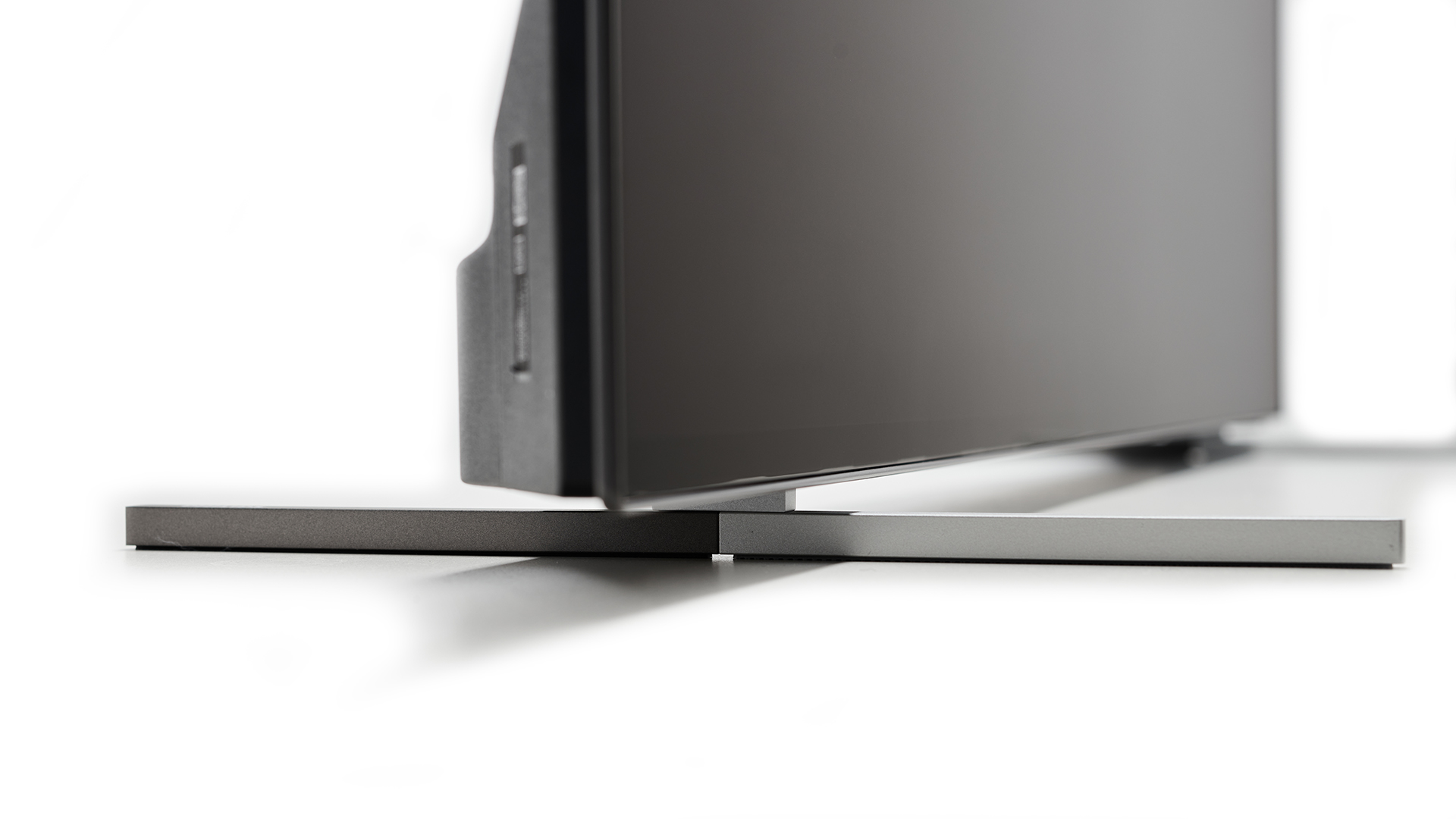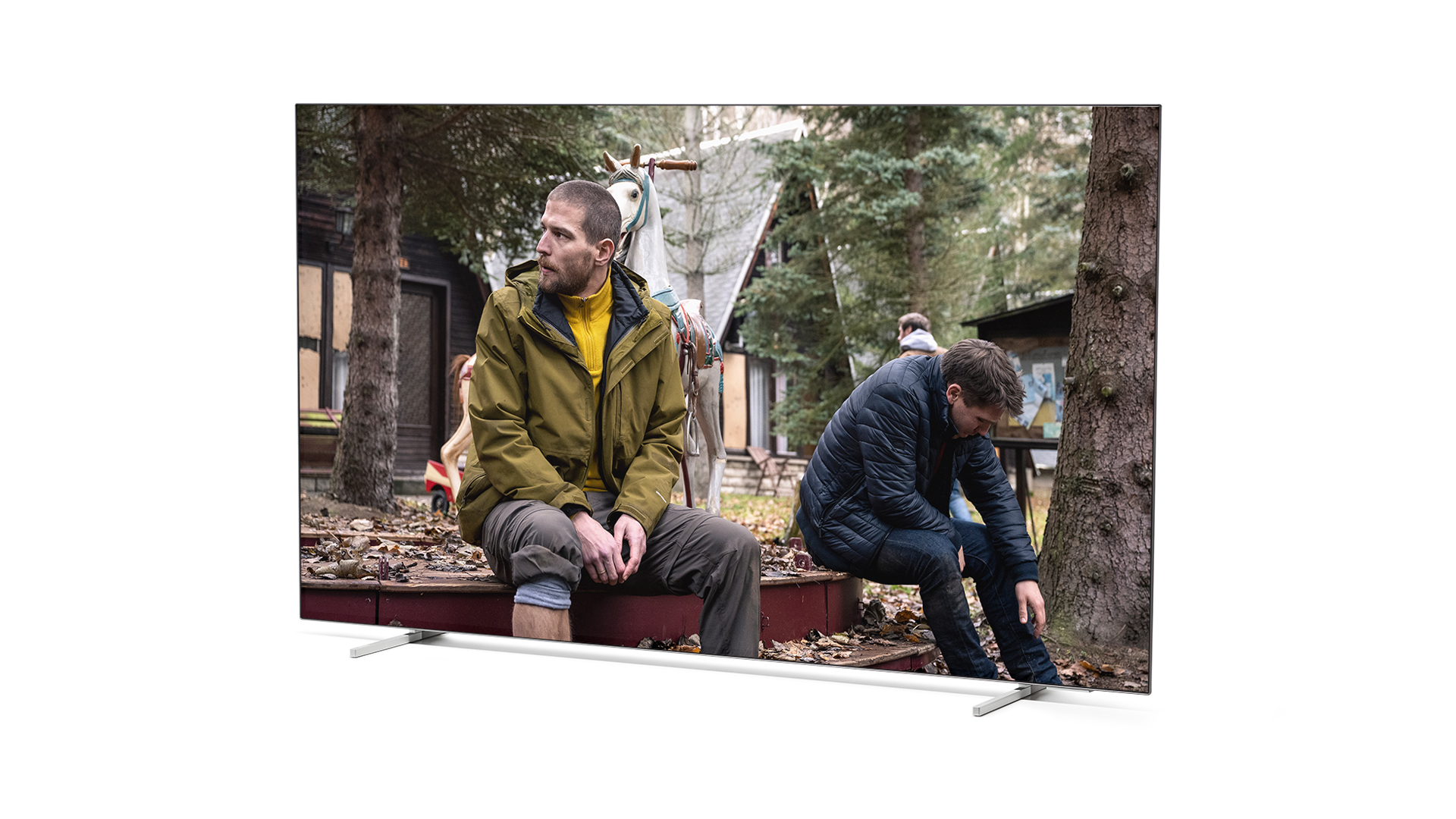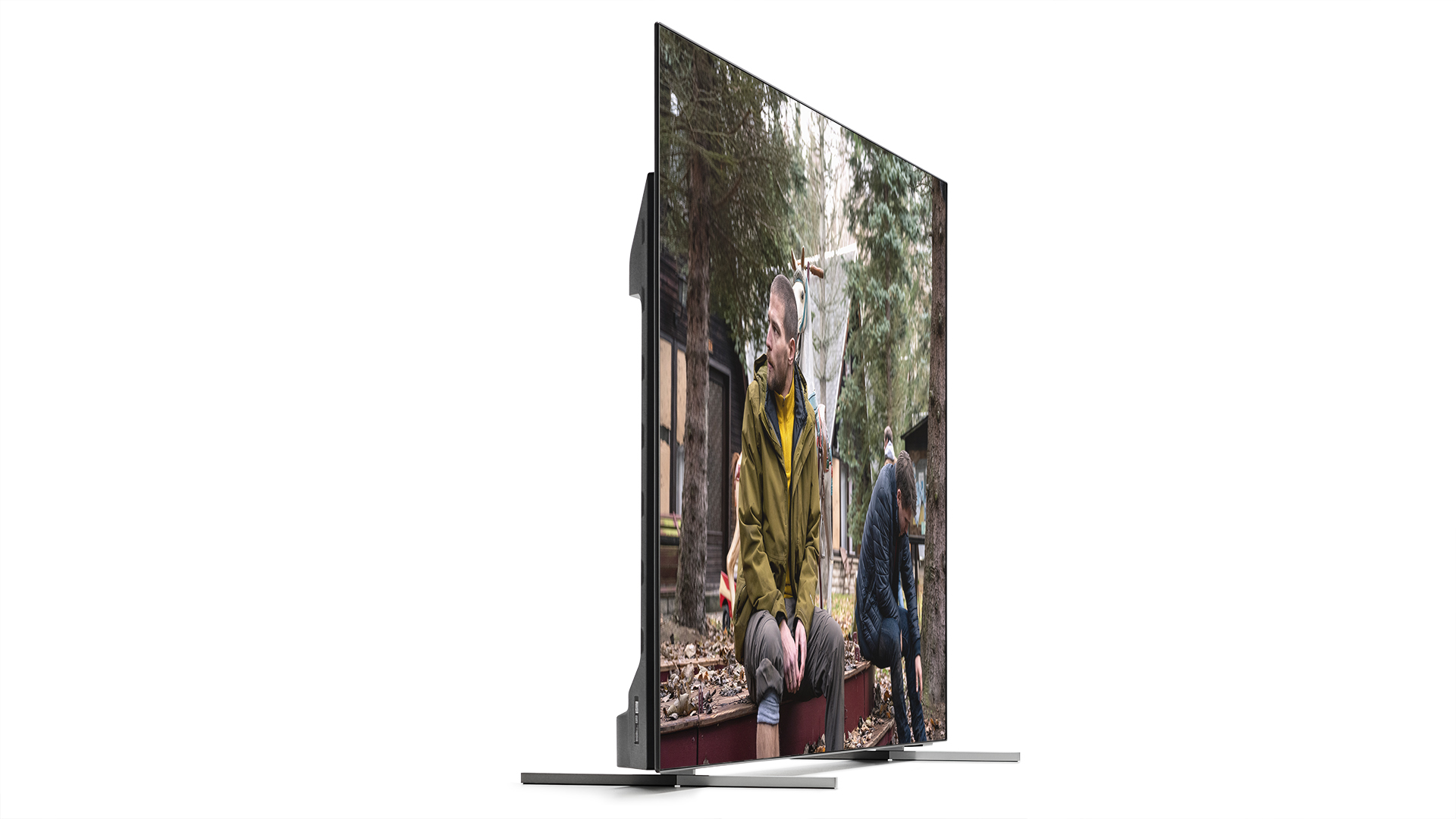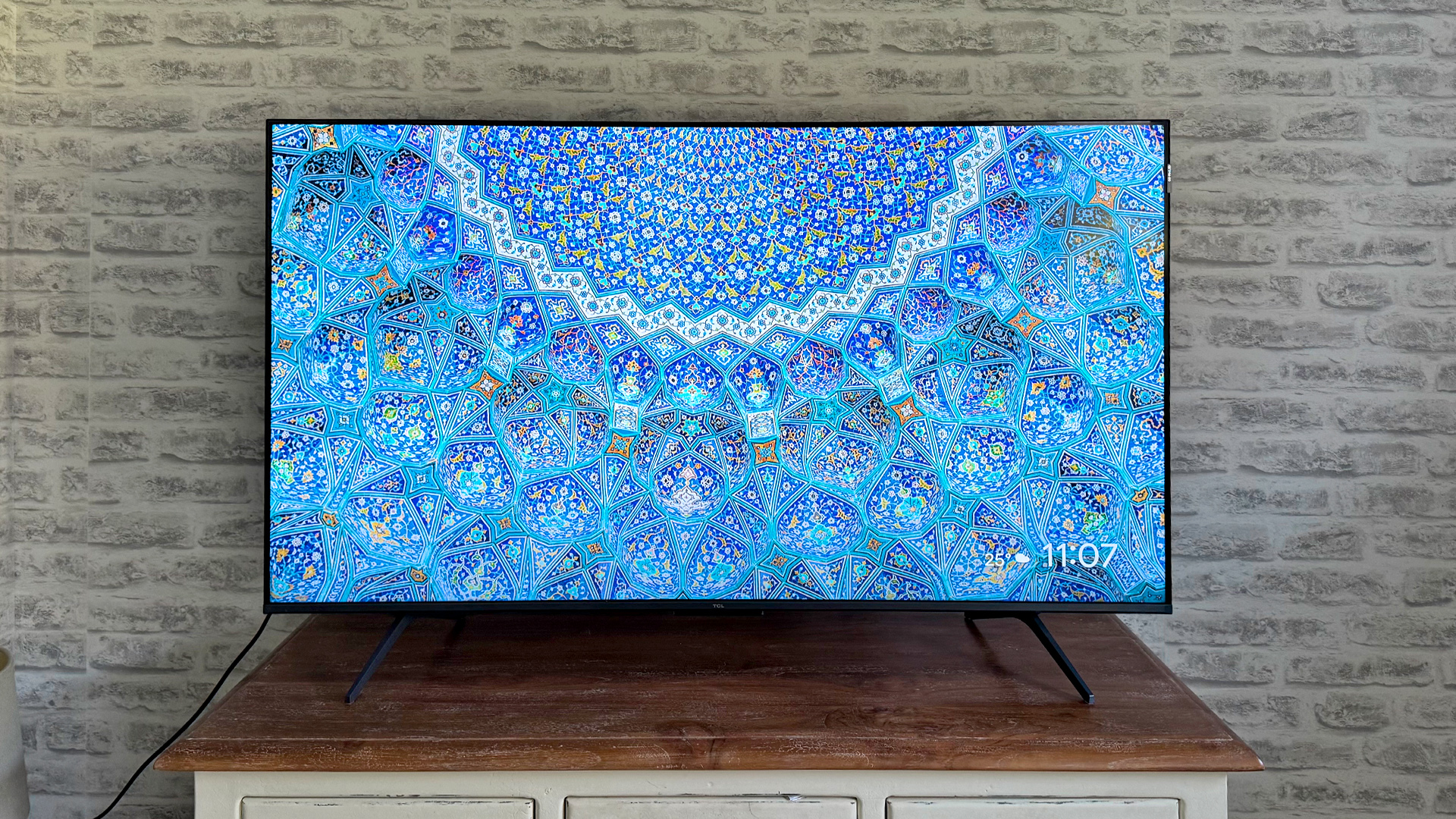What Hi-Fi? Verdict
It’s simply the best picture around at this most convenient of sizes
Pros
- +
Sharp and punchy but natural
- +
Full apps and HDMI 2.1 features
- +
Dolby Vision and HDR10+
Cons
- -
Sound can be bettered
- -
Tricky to get the best out of
Why you can trust What Hi-Fi?
In a world of ever larger TVs, the 48-inch OLED remains a beacon of hope for those with more modest needs. The Philips 48OLED806 is one of the second generation of such televisions, which promise genuine flagship performance at a more manageable screen size – something that’s impossible to find on the LCD side of the market.
You might have a smaller living space, or want a great gaming TV, a screen for the bedroom or perhaps the 48-inch option is a compromise with your less AV-enthusiastic housemate. We’re not here to judge. What we will say is that you’ve already made an excellent choice because last year’s 48-inch OLED TVs proved an absolute scorching hit both with our test team and with the customers who bought them.
The only question that needs answering now is over which of the OLED TV manufacturers is the right one to go with this time around.
Price
The price of the Philips 48OLED806 is £1199 at the time of writing. Like all Philips TVs, it’s only available in Europe.
It’s also possible to pick up an OLED806 in 55-inch, 65-inch and 77-inch sizes.
If you want the same picture quality but with a different stand, try the Philips OLED856. If you want to boost the audio capabilities instead, the Philips OLED+936 comes in a 48-inch screen size, too, and with a Bowers & Wilkins sound system.
- Interested in the 65-inch model? Here's our Philip 65OLED806 review
Build

The Philips 48OLED806 is such a great size. If you’re thinking of replacing a smaller, older TV, then don’t discount this 48-incher. Its minimal bezel might well mean that it comes up a lot smaller than you think.
The latest hi-fi, home cinema and tech news, reviews, buying advice and deals, direct to your inbox.
The 62 x 107 x 28cm dimensions (including the feet) might not mean a huge amount on paper but what it really amounts to is the kind of size and shape that will work in almost any home. The ice-skate feet are simple to fit and require just 78cm of sideboard or shelf to stand on.
Around the back you’ll find more or less everything you could need in the way of ports. There are two HDMI 2.1-rated sockets, two HDMI 2.0s, three USBs, optical out and a headphones socket in case you’d rather go hard-wired instead of Bluetooth (which also features).
Those less familiar with Philips TVs may wonder what the four backwards-facing strips of LED lights around the edge of the rear are all about. This is Philips’s famous four-sided Ambilight system. The LEDs change colour to match the picture on-screen and help make for a more atmospheric and cinematic experience. It might seem a little gimmicky at first, but turn it off and you’ll miss it.

Masterminding the experience, both of Ambilight and everything else that this TV can do, is the second generation Philips P5 AI Perfect Picture engine. It’s packed with image processing technology for sharpening, noise filtering, contrast and light boosting, motion, upscaling and even adding an HDR effect to SDR source material.
Not all of these are a good idea for the best possible picture but they certainly provide plenty of options. The P5 also brings the ability to detect and dull any static images just in case you’re concerned about OLED burn-in issues.
The last piece of infrastructure that you need to know about is the remote control. It’s typical Philips fare – fully-featured, smartly finished in metal and Muirhead leather, and probably a touch more complicated than it needs to be.
Features

It’s a choice between Philips, LG and Sony as far as 48-inch OLED TVs go, and this Philips makes an excellent case for itself as the only one of the three that supports both the Dolby Vision and HDR10+ dynamic HDR standards. Sure, Dolby Vision looks like the one to stand the test of time at the minute, but there’s still plenty of HDR10+ content out there – and why should buyers of a premium OLED TV have to make the choice?
This year, Philips has also thrown HDR10+ Adaptive into the mix. It uses the TV’s light sensor to automatically choose the best brightness settings while watching HDR10+ material, according to your ambient light conditions. Oddly, the equivalent tech on the Dolby Vision side, Dolby Vision IQ, is not included, but the set will still adapt Dolby Vision content to ambient lighting conditions using Philips's own tech.
In this day and age, and especially at this handy, second-screen size, gaming features feel more critical and, unlike Sony’s equivalent, the Sony KD-48A9, you’ll find that the Philips OLED806 is fully stocked here. There are two 48Gbps HDMI 2.1 ports with support for VRR, ALLM and 4K@120Hz. Input lag, meanwhile, measures around 14ms.
One thing to bear in mind is that one of the two HDMI 2.1 sockets is also the one that handles eARC (Enhanced Audio Return Channel), which means that if you have two HDMI 2.1 sources (an Xbox Series X and PS5 or a high-end gaming PC), you’re not also going to be able to send sound via eARC to a soundbar or AV amplifier. This is a limitation of all TVs that we’ve tested that have two HDMI 2.1 sockets and, unlike those others, Philips does somewhat mitigate the issue by supporting standard ARC via its other three HDMI sockets. This won’t get you lossless, TrueHD Dolby Atmos, but it will get you Atmos in the Dolby Digital+ format, and we doubt that many will hear much of a difference.
Well appointed for gaming though the Philips OLED806 is, the LG C1 is even more so, with a set of four HDMI 2.1 sockets and support for 4K@120Hz with Dolby Vision enabled (the Philips taps out at 60Hz with Dolby Vision content).

Screen type OLED
Resolution 4K
Operating system Android TV 10
HDR formats HDR10, HDR10+, Dolby Vision, HLG
HDMI x4 (HDMI 2.1 x2)
4K@120Hz Yes
VRR Yes
ALLM Yes
ARC/eARC eARC
Optical out Yes
Another major differentiator for these sensibly small sets is the operating system and accompanying user experience and app selection. With the best will, we’d have to put Philips at the bottom of the deck in this department. LG has its bespoke, easy to use and sensibly designed webOS and Sony has Google TV. Philips has a combination of Android TV 10 with Freeview Play and its own set of menus lobbed on top. It’s not exactly homogeneous in look and feel, but it works just fine once you get used to it.
In fairness to Philips, Sony’s approach isn’t streets ahead either, but if usability is high up your list you might want to go with the LG. The other thing that LG does well is keep its firmware relatively bug-free and certainly up to date. Philips’s track record isn’t as good on this front and we’ve had trouble with things such as updates for the remote control software with Philips sets in the past. That said, it’s worth noting that we have absolutely no software complaints for the Philips 48OLED806 whatsoever during our review time.
On the plus side, Philips’s mixed OS approach means almost total coverage when it comes to apps and services. All the UK catch-ups are there, Netflix, Prime Video and Disney+ are all available in top quality for sound and vision, and the only significant next-tier app absences are Now and Sky Store.
Should you find it’s missing anything else that you need, you can always use the platform’s Chromecast function to send streams from your phone, tablet or computer straight to your OLED TV.
It’s also worth remembering that the Philips remote is voice-enabled and, thanks to Google Assistant, it’s easy and effective to search for content and other functions by simply talking. After all, aren’t on-screen keyboards a little dated by now?
Picture

If you’re looking for the big reason to buy the Philips 48-inch OLED TV over the other two major players, then this is it: its picture performance is simply the best. Sharper and more sophisticated in its use of light, it just feels a step above.
In previous years, Philips has employed rather heavy-handed detail enhancers to create an impressive but slightly artificial feel of sharpness. This time we find we don’t need them at all. Watching Deadpool in 4K HDR, there are some fabulous textures on show without them switched on. As ever, close-up shots of the actors are a particularly good test. Wade Wilson’s short shaved hair and matching stubble look as if you could reach out and strike a match on them.
What’s even more impressive is how three-dimensionally the anti-hero is rendered compared to the same scene on the other sets. The harsh spotlighting in the dingy Sister Margaret's dive bar can look clumsy and blunt but Philips’ picture processing is able to recognise the scene for what it is and shade Wilson’s face accordingly.
This tricky combination of fine detail and careful shading creates a better feel for every scene than most TVs can manage. The image looks crisp but still solid and natural with a believable depth of field that brings you closer to the action.
It's worth pointing out that getting a picture this good takes a bit of effort. Don’t be afraid to lean heavily on the OLED Contrast, Light Boost and HDR Perfect filters to up the picture punch with HDR material. Otherwise, most processing can be minimised or switched off.

We’re particularly pleased to note Philips’s granular approach to motion processing, which now more or less matches what you’ll find on LG and Samsung TVs. If you want to choose from the presets, Pure Cinema or Movie are the best options but better is to go with the Personal option where you can ramp up the de-blur and find the right place with the de-judder slider set somewhere south of halfway. The end result is the best motion processing we’ve seen yet on a Philips TV. Sony is still king on this front but the gap is closing.
Watching the JJ Abrams Star Trek in HD on Blu-ray, Home Cinema mode feels like the best of the picture presets, but it does still need tweaking. Adjust the motion processing as above, take down the light and HDR boosters, and you’re most of the way there. We’d also recommend pulling back on sharpness to minimise any noise distraction in the picture.
The opening shots of space are awe-inspiring, with the depths of the darkness typically OLED-black, but there is also some decent shadow detail as the giant Romulan ship, Narada, sails past.
Upscaling is performed with consummate ease. While the picture is, of course, not as sharp as genuine 4K, this TV certainly does a good impression. You can still almost smell Captain Robau’s fear in close-up as he’s summoned onboard the enemy vessel and the sweat begins to pool around his pores.
Colour wise, the performance is just as impressive. Whether at 4K or HD, this 806 captures what feels like a true version of each shade. The vintage cherry red Corvette that the young Kirk joyrides, the green of the crops in the fields that he flies by and the dusty roads he speeds down seem typical of a small town Iowa countryside of the not too distant future.
Even down at SD, colour accuracy manages to hold. Watching the 1970s-looking The Lady in The Van, Alan Bennett’s mustard jacket and the Camden street walls are illustrated in distinct and believable shades.
DVDs such as this are a surprisingly smooth watch, despite the lack of native detail. There are few rough edges and, although the picture is very soft compared to higher resolution, we’re perfectly happy to take in scene after scene until we find that most of the film is done.
Sound

There’s nothing particularly groundbreaking about the sound technology built into this TV, but the simple, rear-facing 2.1ch, 50W, three-speaker system does a very respectable job, particularly at this small panel size. There’s not so far for the sound to travel around the back of the screen before it heads out into your room and the results are an audio presentation that does the job pretty respectably.
Of the sound presets, it’s best to stick to Original, or AI mode if you’re happy for your set to make its own choices depending on what kind of content you’re using, whether that’s music, films, TV, sports or anything else.
Movie mode is the only other one worth considering for general viewing. The surround virtualiser does an excellent job of jetting the effects way out to the side of our space as we watch Star Trek. The futuristic traffic cop’s bike seems to zoom right round the edge of our room as he chases the young James Tiberious Kirk off the country roads and into the corn fields.
The downside is that voices and music sink into the background, so it won't suit all tastes or content. On occasion, though, the sacrifice is worth making for a more cinematic experience.
All the same, if that’s what you really want, then a soundbar would really do this set some sonic justice. This Philips can detect and pass through Dolby Atmos content down its eARC/ARC sockets, making something such as one of the Sonos soundbars a particularly good choice.
On its own the Philips audio set-up treads a decent line of tonal balance. It’s not blessed with the kind of agility to produce much in the way of impact when the alien craft unleashes its clustering photon torpedoes in the opening space battle. There’s little to the explosions as they collide with the Starfleet vessel’s hull nor any particular crackle as the fires break out on board the USS Kelvin in these sonically busy scenes, but when the action drops back there’s enough under the hood for some detail and dynamism.

The turbo lift doors sound right as they slide open and closed, there’s plenty of bleeps and cheeps from the ship’s computer nicely placed into the soundstage and there’s a very decent sense of atmosphere as Captain Robau is led through the echoey Romulan ship.
Even without the surround virtualiser, there’s some clear direction to the phasers firing at all angles during the battle scene too. While the sound is more centred around the panel it does project some way out to the sides and towards our seating position.
For the next level up for sound, the Sony A9 would be the way to go with its sound-from-picture technology. While weight won’t be greatly improved, it edges the Philips for clarity, particularly when it comes to voices.
Despite its imperfections, though, the OLED806 still covers the basics pretty well. It commits no major audio crimes and can still convey the emotion in Michael Giacchino’s excellent score when it counts. It’s true lump-in-the-throat stuff as George Kirk steers his ship towards oblivion, listening over comms to the first moments of life of a son he’ll never get to meet.
Verdict
The Philips 48OLED806 may not be the easiest to use nor does it have the very best sound. However, the picture performance on this small-sized set is quite something else. Head and shoulders above the rest, it’s the best on the market at the moment for those after a premium TV with a more manageable footprint.
Pair it with an external sound system and you’ve got an AV force to be reckoned with, whether for watching films or playing games. This is the one to watch.
SCORES
- Picture 5
- Sound 4
- Features 5
MORE:
Read our Sony KD-48A9 review
Read our thoughts on the LG OLED48CX
Also consider the Sony KD-49XH9505
The best TVs under £1000: 4K, HDR and budget TVs
Dan is a staff writer at What Hi-Fi? and his job is with product reviews as well as news, feature and advice articles too. He works across both the hi-fi and AV parts of the site and magazine and has a particular interest in home cinema. Dan joined What Hi-Fi? in 2019 and has worked in tech journalism for over a decade, writing for Tech Digest, Pocket-lint, MSN Tech and Wareable as well as freelancing for T3, Metro and the Independent. Dan has a keen interest in playing and watching football. He has also written about it for the Observer and FourFourTwo and ghost authored John Toshack's autobiography, Toshack's Way.

